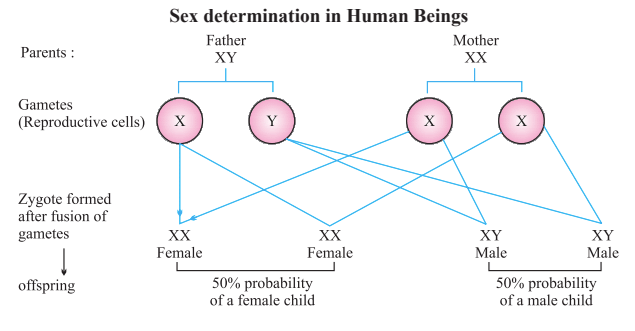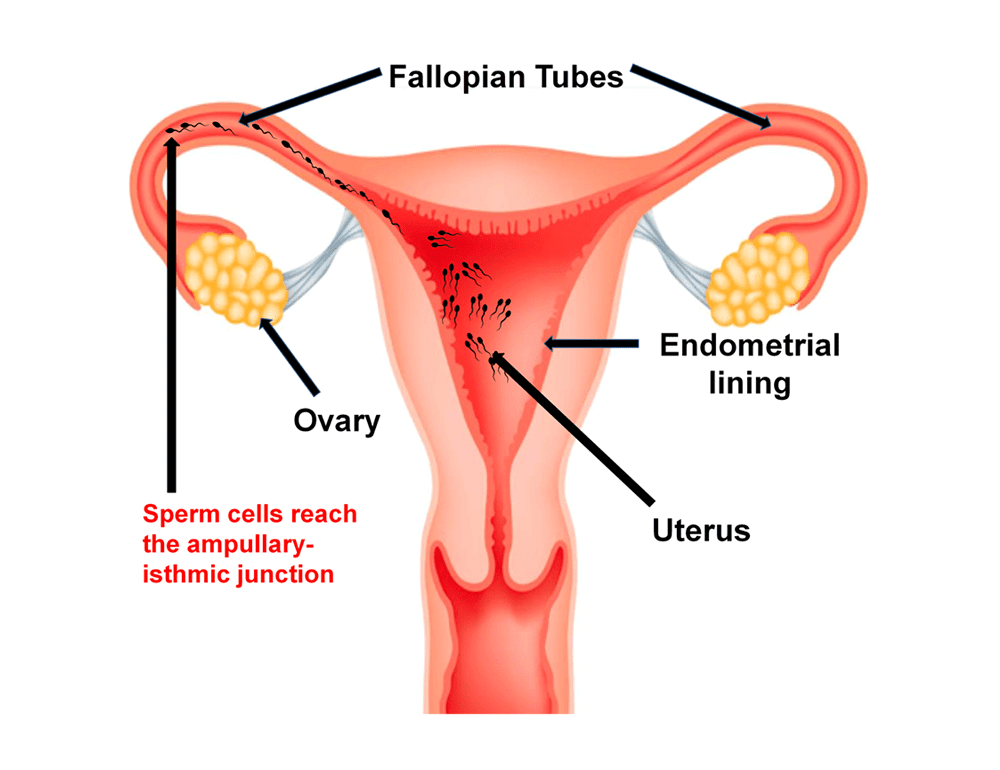Human Reproduction: Assertions & Reason Type Questions- 1 | Biology for Grade 12 PDF Download
Directions: In the following questions a statement of assertion (A) is followed by a statement of reason (R). Mark the correct choice as :
Question 1:
Assertion (A) : In human male, testes are extra- abdominal and lie in scrotal sacs.
Reason (R) : Scrotum protects the testes.
(a) Both assertion (A) and reason (R) are true and reason (R) is the correct explanation of assertion (A).
(b) Both assertion (A) and reason (R) are true but reason (R) is not the correct explanation of assertion (A).
(c) Assertion (A) is true but reason (R) is false.
(d) Assertion (A) is false but reason (R) is true.
Correct Answer is Option (a)
The scrotum is a bag-like structure that helps to protect the testicles. Testicles make sperm and for this, they need to be cooler than the inside of the body. This is why the scrotum is located outside the body.Male Reproductive System
Question 2:
Assertion (A) : Large member of mitochondria are present in middle piece of sperm.
Reason (R) : Numerous mitochondria in the middle piece of sperm produce energy which is required for their movement.
(a) Both assertion (A) and reason (R) are true and reason (R) is the correct explanation of assertion (A).
(b) Both assertion (A) and reason (R) are true but reason (R) is not the correct explanation of assertion (A).
(c) Assertion (A) is true but reason (R) is false.
(d) Assertion (A) is false but reason (R) is true.
Correct Answer is Option (a)
Mitochondria is a power house organelle. It stores energy in the form of ATP. This energy helps in sperm motility.Mitochondria in Midpiece of Sperm
Question 3:
Assertion (A) : Vasa efferentia develop from rete testis.
Reason (R) : Sperm conduction takes place by the ciliary current.
(a) Both assertion (A) and reason (R) are true and reason (R) is the correct explanation of assertion (A).
(b) Both assertion (A) and reason (R) are true but reason (R) is not the correct explanation of assertion (A).
(c) Assertion (A) is true but reason (R) is false.
(d) Assertion (A) is false but reason (R) is true.
Correct Answer is Option (a)
Vasa efferentia are short, straight tubes, develop from rete testis. They help in sperm conduction which takes place by the ciliary current.
Question 4:
Assertion (A) : Oxytocin helps in parturition.
Reason (R) : Oxytocin acts on uterine muscle and causes expulsion of the foetus.
(a) Both assertion (A) and reason (R) are true and reason (R) is the correct explanation of assertion (A).
(b) Both assertion (A) and reason (R) are true but reason (R) is not the correct explanation of assertion (A).
(c) Assertion (A) is true but reason (R) is false.
(d) Assertion (A) is false but reason (R) is true.
Correct Answer is Option (a)
Oxytocin acts on uterine muscles and also increases the production of prostaglandins, which increase the contractions further.
Question 5:
Assertion: The gamete formed in males determines the sex of the offspring.
Reason: Sex determination in human depend upon cumulative effect of some genes of X and Y chromosomes.
(a) Both assertion (A) and reason (R) are true and reason (R) is the correct explanation of assertion (A).
(b) Both assertion (A) and reason (R) are true but reason (R) is not the correct explanation of assertion (A).
(c) Assertion (A) is true but reason (R) is false.
(d) Assertion (A) is false but reason (R) is true.
Correct Answer is Option (c)
Sex determination depends either of the chromosome contributed by male, If chromosome is contributed in zygote formation the offspring will be male and if Y is contributed then the offspring will be female.
Question 6:
Assertion (A) : Urethra in human male act as a urinogenital canal.
Reason (R) : Urethra carries only urine while sperms are carried by vasa deferentia only.
(a) Both assertion (A) and reason (R) are true and reason (R) is the correct explanation of assertion (A).
(b) Both assertion (A) and reason (R) are true but reason (R) is not the correct explanation of assertion (A).
(c) Assertion (A) is true but reason (R) is false.
(d) Assertion (A) is false but reason (R) is true.
Correct Answer is Option (b)
Urethra is the canal through which both urine and semen is discharged therefore it is called urinogenital canal.
Question 7:
Assertion (A) : The region outside the seminiferous tubules is called interstitial spaces, which contain Leydig's cells.
Reason (R) : Leydig's cells synthesize and secrete testicular hormones called androgen.
(a) Both assertion (A) and reason (R) are true and reason (R) is the correct explanation of assertion (A).
(b) Both assertion (A) and reason (R) are true but reason (R) is not the correct explanation of assertion (A).
(c) Assertion (A) is true but reason (R) is false.
(d) Assertion (A) is false but reason (R) is true.
Correct Answer is Option (b)
Hypothalamus releases GnRH. This hormone stimulates the secretion of LH, which further acts on interstitial cells of Leydig and induces the release of androgen.
Question 8:
Assertion (A) : The secretory phase in the human menstrual cycle is also called the luteal phase.
Reason (R) : During the luteal phase development of corpus luteum and secretion of progesterone occurs.
(a) Both assertion (A) and reason (R) are true and reason (R) is the correct explanation of assertion (A).
(b) Both assertion (A) and reason (R) are true but reason (R) is not the correct explanation of assertion (A).
(c) Assertion (A) is true but reason (R) is false.
(d) Assertion (A) is false but reason (R) is true.
Correct Answer is Option (a)
The luteal phase begins after ovulation. It lasts about 14 days, and ends just before a menstrual period. In this the ruptured follicle closes after releasing the egg and forms the corpus luteum.
Question 9:
Assertion (A) : The fusion of sperm and ovum to form zygote is called fertilization.
Reason (R) : It occurs at ampullary isthmic junction of the fallopian tube.
(a) Both assertion (A) and reason (R) are true and reason (R) is the correct explanation of assertion (A).
(b) Both assertion (A) and reason (R) are true but reason (R) is not the correct explanation of assertion (A).
(c) Assertion (A) is true but reason (R) is false.
(d) Assertion (A) is false but reason (R) is true.
Correct Answer is Option (b)
Fertilization in humans occur at the ampullary isthmic junction of the fallopian tube. The fusion of sperm and ovum to form a zygote is called fertilization.
Question 10:
Assertion (A) : Endometrium is a mucosal tissue made up of two layers.
Reason (R) : It is a inner lining of the uterus. Each month it thickens and renew itself, preparing for pregnancy.
(a) Both assertion (A) and reason (R) are true and reason (R) is the correct explanation of assertion (A).
(b) Both assertion (A) and reason (R) are true but reason (R) is not the correct explanation of assertion (A).
(c) Assertion (A) is true but reason (R) is false.
(d) Assertion (A) is false but reason (R) is true.
Correct Answer is Option (a)
It's two layers-the stratum functionalis and stratum basalis. If conception takes place, the embryo implants into the endometrium.
|
124 videos|215 docs|236 tests
|
FAQs on Human Reproduction: Assertions & Reason Type Questions- 1 - Biology for Grade 12
| 1. What are the main stages of human reproduction? |  |
| 2. How does fertilization occur in humans? |  |
| 3. What is the role of hormones in human reproduction? |  |
| 4. How long does human pregnancy typically last? |  |
| 5. What are some common factors that can affect human fertility? |  |


















